|
|
| |
|
|
 |
|
Rear
Admiral Steve Ritchie about the effort to maintain Collieston
pier in good repair. Colvid0010
|
|
|
| |
|
 |
| |
Collieston
pier is pounded very heavy seas
Colvid0007
|
|
| |
|
|
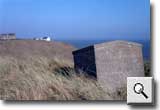 |
| Pier
construction |
| |
| The
concrete 'hut' is a reminder of the construction
of the Pier, which was built in 1894. Still standing
at a slant at the top of the Brae on the south
side of Perthudden, this curious structure was
built to house the explosives used in the Pier
work. |
| |
| For safety’s
sake the explosives were transported to the site by
boat from Perthudden rather than being carted through
the village. Looking at the Brae on the north of Perthudden,
Slains Lodge the former Whiteness Hotel is clearly visible.
|
| |
To
the right of Slains Lodge is a white washed cottage
facing out to sea, formerly the lookout post of the
Collieston Auxiliary Coastguard Company.
|
|
|
| |
The
Pier during construction |
|
| |
Looking
from the high ground above the quarry in Cransdale,
towards the north side of Collieston Pier whilst it
was under construction.
The North and South entrances where the fishing
boats entered or left before the Pier was completed
are visible as are the rock formations on which
the Pier was built. A crane, used in the construction,
can be seen on the right of the picture.
In the foreground fish, probably cod or ling, are drying
on racks. Beyond the Pier Slains Lodge, formerly known
as Whiteness Hotel, is clearly identifiable on the cliff
top.
|
|
|
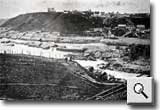 |
| |
|
|
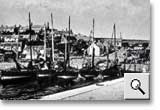 |
Fishing |
|
| |
| The
Collieston fishing fleet of larger, tall masted,
yawls in port circa 1900. Some of the fishermen’s
gear can be seen lying on the Pier. Beyond the
yawls, the gable end of the cottage now known
as ‘Buckies’ is easily identifiable,
as is the line of the road running from the
harbour
up to the village. |
| |
In wintertime
the yawls were taken to the shelter of the Ythan Estuary
|
| |
|
|
North across
Collieston Harbour
Circa 1910, looking at the northerly part of the village.
On the horizon, behind the grassy mound known as the ‘Rivie’,
Slains Kirk and Collieston School are clearly visible.
In the foreground a beached yawl lies on the rocky
foreshore while two more yawls can be seen on a part of the
foreshore where sand is beginning to accumulate after the
recent construction of the Pier.
The houses at the foot of the ‘Rivie’ are built
on the area of the village known as the Cliff. Some of the
houses subsequently fell into decay and were later demolished
but many of them were preserved and modernised.
|
 |
| |
|
|
 |
| Edwardian
tourist watching fishwives on Pier |
| |
Circa
1905, fishwives and fishermen from the village. The
fishwives are Annie Wilson, Aggie and ‘Old
May’, while standing nearby are the fishermen
known as ‘Captain Sandy Ad’ and ‘Jock
Retch’.
The well-dressed lady is Molly Clark who, along with several other visitors is
watching the fishwives hard at work on the Pier as they sort the catch of fish
and get them ready for cleaning and gutting.
To the right of the Pier is the area of the village
known as the Cliff and the line of the road running
from the harbour up to the village is clearly identifiable.
Some of the houses subsequently fell into decay and
were later demolished but many were preserved and modernised.
|
| |
|
|
| |
|
|
| |
| The
Pier |
| |
Collieston
viewed from Cransdale in 1957. Waves, fuelled by a
north-easterly wind, are crashing against the Pier
wall. Built in 1894, the Pier had had to endure more
than one hundred years of pounding by the North Sea
and had sustained some damage along the way.
By the late 1950’s the Pier was in a sad state of repair. Sir
Douglas Ritchie, who had recently retired to the family home in the
village, proposed the formation of a Collieston Amenities Committee.
Formed in 1957, its purpose was to raise money for the maintenance
of the Pier as well as the unique system of roadies or paths that
ran throughout the village.
To the rear are the relatively calm waters of the protected
harbour. Clearly visible on the horizon behind the crashing
waves is the headland known as the Braehead, a popular
vantage point for both locals and visitors.
|
| |
|
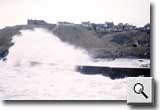 |
| |
|
|
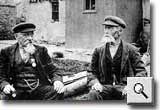 |
| Two
Veterans |
Circa 1920,
two men, one of whom is sporting a medal. Johnny Brand,
seated on the right, won his Sebastopol medal for service
during the Crimean War (1853-1856).
Johnny had originally come to the village to work as
a diver employed on the construction of the Pier. He
subsequently married a local girl and stayed on in the
village after the construction of the Pier was completed.
The man seated on the right is Jimmy Main, known as ‘Cooncillor’,
who was chairman of the School Board.
|
| |
|
|
| |
|
|
| |
| The
Pier |
| |
The Pier
showing signs of damage circa 1988. Some £60,000
was raised to carry out extensive repairs. To reflect
the change of use of the harbour from commercial fishing
to leisure and recreation, the ‘Collieston Harbour
Act of 1894’ was updated by Parliament as ‘The
Collieston Harbour Revision Order, 1991’. This
came into force in November of that year.
To fulfil the requirement of this Order, Harbour Trustees
were re-established and a fund was set up to ensure
that, as far as possible, the cost of repairs to the
Pier might be met.
|
| |
|
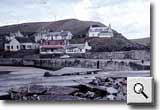 |
| |
|
|
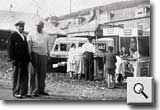 |
| First
Gala Day |
Sir Douglas
Ritchie (left) and Richard (Dick) Donald (right), a
resident of the village and Director of Aberdeen Football
Club, are standing in front of a stall and marquee at
the first Gala Day in 1958.
By the mid 1950’s the Pier, built in 1894, was
in a sad state of repair. Sir Douglas Ritchie, from
an old Collieston family and formerly Vice Chairman
of the London Port of Authority, had retired to the
family home in the village and proposed the formation
of a Collieston Amenities Committee.
Formed in 1957, its purpose was to attempt to raise
money for the maintenance of the Pier and the unique
system of roadies or paths that ran throughout the village.
The first Gala Day to raise money for this conservation
task was held in 1958. The Pier was duly repaired and
Gala Day has been a feature of village life every summer
since.
|
| |
|
|
|
|
|
|
|
|
|
copyright
collieston's century 2003 |
|